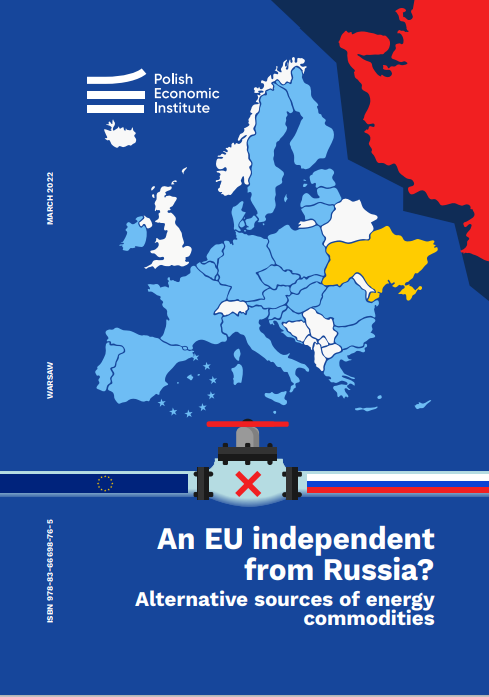EU could become independent from Russian commodities already in 2022

Published: 07/04/2022
The EU is largely dependent on energy commodities imported from Russia. 25% of the crude oil, 45% of the natural gas and 44% of the hard coal imported by the EU come from Russia. Yet as the Polish Economic Institute’s report entitled “An EU independent from Russia? Alternative sources of energy commodities” shows, the EU’s dependence on energy commodities can be reduced significantly. The EU could reduce gas imports from Russia by as much as 91% as already in 2022, the PEI’s analysis shows.
“The Russian and Belarusian attack on Ukraine has renewed the discussion on the EU’s independence from energy commodity imports from Russia. Energy commodity exported to the EU generate more than a fifth of the Russian budget and directly finance the Putin regime’s war machine. We are at a historic moment with a chance for a breakthrough in the EU’s energy policy. If the change in thinking on this subject continues, Europe could become fully independent from Russia in terms of energy,” said Piotr Arak, director of the Polish Economic Institute.
Crude oil
The EU has been less dependent on oil imports from Russia over the past three years. In addition to Russia, which supplies around 25% of the EU’s oil, the bloc imports oil from Norway, Kazakhstan, the US, Saudi Arabia, Nigeria, Iraq and other countries. In Poland, the share of Russian oil in consumption and imports overall had fallen by around 30 pp and was slightly above 60% in 2021.
The countries in Central and Eastern Europe (CEE) are more dependent on Russian oil than those in the west. France, Austria and Spain imported less than 10% of their oil from Russia. Germany, the Netherlands and Belgium imported the most oil in nominal terms. There, Russian oil accounted for around 20-30%, compared to over 60% in Slovakia, Finland, Bulgaria and Hungary.
Natural gas
Russian gas accounts for around 45% of total gas imports and 40% of consumption in the EU market. As in the case of oil, the CEE countries are more dependent on gas deliveries from Russia. Nominally, the largest importers are Germany, Italy, Hungary and the Netherlands.
“In March 2022, the European Commission proposed an outline of a plan to make the EU independent from Russian fossil fuels by 2030, calling for a 65% reduction in gas imports from Russia this year. The International Energy Agency is talking about a reduction of 66%. The report by the Polish Economic Institute shows that additionally by reducing air conditioning by 2oC in the summer and managing the demand side by reducing consumption in industry, gas imports could be reduced by as much as 91% at EU the level. This type of actions altogether could reduce Russia’s profits from gas exports to the EU four times more than the solutions proposed by the European Commission and IEA,” said Magdalena Maj, head of the climate and energy team at the Polish Economic Institute.
A significant challenge – in particular, for the Czech Republic, Slovakia, Hungary, Austria, Slovenia, Latvia, Estonia, Finland and Ireland, would be the winter of 2022-2023 due to potential difficulties in filling European warehouses before the next heating season.
Hard coal
Russian coal imports to the EU have increased in recent years; in 2019, they amounted to 56 million tonnes. Russian hard coal accounts for around 45% of coal imports and around 30% of consumption. Germany and Poland import the most coal from Russia in nominal terms. Russian coal is relatively cheap, so imports of it have increased in several countries. Low supply in global markets limits the alternatives to Russian coal. Imports from the US, Australia and South Africa could potentially be increased.
In Poland, coal consumption decreased by more than 40% in 1990-2020. Currently, about 80% of the coal imported from Russia is used as fuel for households. Only around 5% is directed towards industry. The rest mainly goes to heating plants. The further decarbonization of the EU economy, including in Poland, will reduce the coal’s role as a source of energy in the coming years.
How to reduce energy commodity imports from Russia
The EU’s potential to limit imports of each type of energy commodity from Russia varies. In the short term, the resumption of exports from Iran and the use of current reserves would enable the EU to prepare to cut itself off from Russian oil long term, thereby reducing the value of Russia’s exports by more than USD 50 billion.
“The lasting diversification of oil supplies does not require significant investments in infrastructure. Already today, most of the EU’s imports arrive by sea. In the past year, as much as half of the capacity of the Naftoport Polish Oil Terminal was unused. Increasing crude oil production in North America would provide nearly 1 million barrels a day, around 40% of the crude oil imported from Russia. Additionally, the EU could increase import by 0.8 million b/d due to supply chains changes from Norway, UK and Denmark and increase in Canada export to USA.,” said Magdalena Maj.
The PEI report shows that the EU could become over 90% independent from gas deliveries from Russia. Increasing the use of existing infrastructure would help; the average use of European LNG terminals was only 46% in 2021.
A crucial part of strengthening the EU’s strategic energy security when it comes to gas would be the development of infrastructure: increasing the use of LNG terminals, expanding them, and accelerating the construction of new terminals. Interconnector projects enabling the newly-created storage capacities to be fully used and filled are also needed.
In addition to diversifying energy commodity supplies, the EU could reduce demand for energy through changes in consumer behavior. The simplest way is to reduce room temperature by 1oC during the heating season and air conditioning use by 2 oC during the summer. Programmes for replacing of heating sources and thermo-modernization of buildings need to be implemented, too. In transport, it is worth promoting public transport and changing driving style, to make it more efficient in terms of fuel consumption – added Maciej Miniszewski.
***
The Polish Economic Institute is a public economic think tank dating back to 1928. Its research primarily spans macroeconomics, energy and climate, foreign trade, economic foresight, the digital economy and behavioural economics. The Institute provides reports, analyses and recommendations for key areas of the economy and social life in Poland, taking into account the international situation.
Media contact:
Ewa Balicka-Sawiak
Press Spokesperson
T: + 48 727 427 918
E: ewa.balicka@pie.net.pl
Kategoria: Analysis / Press releases / Report / Reports 2022 / Russia's invasion of Ukraine






